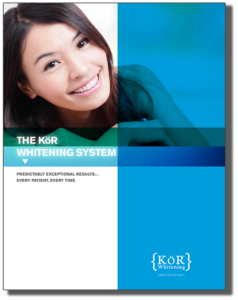Dr. Nayda asked – “What toothpaste do you recommend while the patient is whitening?”
I recommend most versions of the Sensodyne “ProNamel” Toothpaste during whitening.
The real question is, why do I recommend ProNamel? No, it’s NOT because the manufacturer pays me or lets me use their Yacht (although that would be nice 😉). I do not have, nor have I ever had, any affiliation with GSK (GlaxoSmithKline) whatsoever. In fact, I don’t even know one person at the company.
I recommend ProNamel for three reasons: it contains 5% potassium nitrate, it does not contain SLS, and it does not contain pyrophosphate. I’ll explain…
Potassium nitrate (PN)
Potassium nitrate (PN) is a teeth desensitizer. Given my extensive experience, as well as my very in-depth review of the scientific literature over the past few decades, I have found that PN does a great job of desensitizing on about 1/3 of all patients. It’s moderately helpful on about another 1/3 of patients. And doesn’t help at all on another 1/3 of patients.
But my attitude is that it certainly can’t hurt!
PN is definitely not my first line of defense against sensitivity – KöR Complete desensitizer is my “big gun.” But I’ll take anything I can get to help prevent sensitivity for my patients.
Regardless of what you may have heard, PN does not plug dentinal tubules whatsoever. It simply migrates down the dentinal tubules (which typically takes time) and interrupts the ability of the A-Delta neurons lining the pulp to re-polarize after firing. You need time for it to build up in sufficient concentration in the pulp. And you need continuous use over time to keep the pulpal concentrations up. And again, it doesn’t work for everyone.
Brushing with ProNamel during whitening, and a week or two prior to whitening, may help take the edge off any sensitivity a highly sensitive patient might feel. But there is an even more important use for ProNamel.
Remember that time is essential with PN effectiveness. The longer you can keep it on the teeth, at a full 5% concentration, the more effective it will be. Obviously, when brushing, the toothpaste dilutes quickly.
At KöR Whitening, for any patients you suspect may be unusually sensitive, we recommend using “desensitizing trays,” which are similar to KöR-Seal Whitening Trays, except the desensitizing trays, cover the gingival margins. For unusually sensitive patients, a common treatment is wearing the desensitizing trays filled with a 5% PN product for 30-60 minutes at a time.
Professional PN products can be very pricy. And professional products contain no more PN than ProNamel. So we like to suggest that ProNamel be used in desensitizing trays instead of high-cost professional PN products. We have found absolutely no difference between the effectiveness of high-cost PN products and ProNamel when used in desensitizing trays.
SLS (sodium lauryl sulfate)
SLS is a detergent. It makes products foam. From a psychological standpoint, we love our toothpaste to foam as we brush. It makes us feel like we’re being effective. But the fact is that foaming provides absolutely no benefit other than psychological.
The problem is that SLS detergent is basically a soap – it will dissolve grease, fats, etc. The soft tissues of our mouths contain lipids. Lipids are fats. SLS leaches/dissolves away some of those lipids from our oral tissues. For most of us, merely brushing with SLS causes no problem. But for people who suffer from painful canker sores – oh brother! SLS may increase the frequency and size of canker sores BIG TIME! So my advice to canker sore sufferers – never use a toothpaste with SLS.
When wearing whitening trays every night, the edges of the trays will commonly irritate the edge of the gums slightly. I do not want to compound any slight irritation of the gumline by having SLS in the desensitizing trays for 30-60 minutes at a time, leaching out the lipids from the gum tissue.
Pyrophosphate
Pyrophosphate is the “tartar control” ingredient in many kinds of toothpaste. As one of the original beta testers of the first tartar control toothpaste, I found many of my “test” patients developing tooth sensitivity – most often just one or two teeth. The percentage of patients who experienced sensitivity (sometimes severe) was far more than coincidence. So I withdrew my patients from the beta test study. Every patient with sensitivity returned to normal within a couple of days after discontinuing the tartar control toothpaste.
I’m sure most, if not all, dentists reading this blog post have read articles about this problem with toothpaste containing pyrophosphate.
Remember that tartar buildup (calculus) is made of hydroxyapatite (HA). Other things made of HA include: natural dentinal smear plugs, dentin of teeth, enamel of teeth, and our bones. I won’t waste time here discussing the science behind this, but you can imagine that a chemical that interferes with the formation process of calculus would also interfere with the formation of natural smear plugs. When smear plugs are missing from dentinal tubules, sensitivity becomes a problem.
So, of course, I do not want the toothpaste in the desensitizing trays to have pyrophosphate soaking against tooth structure for 30-60 minutes at a time.
Also…
There is another reason that I like most versions of ProNamel toothpaste – low abrasion. Abrasion is a problem for most adults. Dentists reading this will understand this very well.
Toothpastes are graded by the American Dental Association (ADA) regarding how abrasive the toothpaste is. Each toothpaste is given a Relative Dentin Abrasion (RDA) rating. The following is a breakdown of the RDA scale:
0-70 Low Abrasive
71-100 Medium Abrasive
101-150 Highly Abrasive
151-250 Regarded as Harmful Limit
By far, the majority of toothpaste today falls into the medium to highly abrasive categories. In contrast, most versions of Sensodyne ProNamel toothpaste fall at the lower end of the low abrasive category.
The following list of Sensodyne ProNamel Toothpaste versions shows their individual RDA rating. These RDA numbers came directly from GSK today, October 1, 2020:
Version of ProNamel Toothpaste RDA rating
Daily Protection 35
Fresh Breath 35
Intensive Enamel Repair 35
Repair & Protect Whitening 35
Intensive Enamel Repair Whitening 35
Multi-action 103
Gentle Whitening 103
Strong & Bright Enamel 132

Dr. Rod Kurthy


